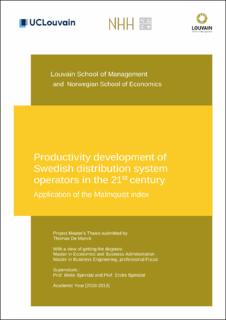Productivity development of Swedish distribution system operators in the 21st century : application of the Malmquist index
Master thesis
Permanent lenke
https://hdl.handle.net/11250/2644034Utgivelsesdato
2019Metadata
Vis full innførselSamlinger
- Master Thesis [4372]
Sammendrag
Nowadays, Data Envelopment Analysis (DEA) is a well-established practice to apply in
network regulation. More specifically, DEA can turn out to be a proper tool to evaluate
the productivity development of an industry. From the Network Performance Assessment
Model to the Revenue Cap Model and passing through a low-powered rate-of-return regime,
Sweden experienced a broad range of regulatory scheme. This study is the opportunity to
evaluate the impact on the industry of the two mentioned regulatory schemes. Through
a Malmquist productivity index, our study encompasses a productivity analysis of the
Swedish electricity distribution sector from 2002 to 2017. Besides, a Kruskal-Wallis test
and a Tobit regression helped us evaluate if factors such as the ownership type or the
customer density could have an influence on the performances of the operators. Among
other results, we have demonstrated the low-robustness of the Network Performance
Assessment Model and the stability of the industry from the establishment of the Revenue
Cap Model onwards. Recommendations to the Swedish Energy Inspectorate are also
given such as a revision of the general efficiency requirement imposed to the operators
or the inclusion of environmental variables. Furthermore, the results have shown that it
is likely that private operators present better performances than municipally-owned and
cooperative operators.
